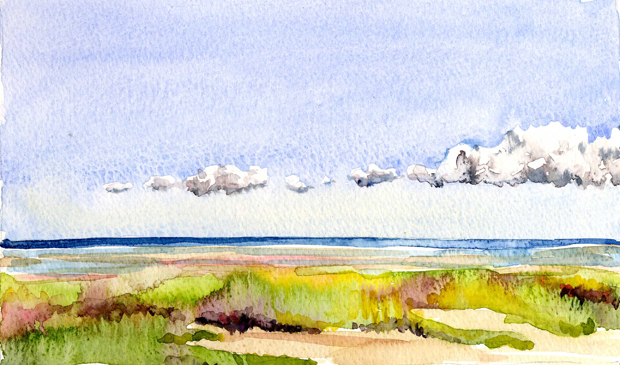It’s one thing to name the stories that are replacing damaging ones like superiority and scarcity, and it’s quite another to bypass description and go straight to a sensory, emotional response to an experience. In recent years, I’ve been learning and experimenting with practices that cultivate embodied connection.
A few years ago, it occurred to me that I had been communing with places for many years through my watercolor paintings. Beaches, coves, and trees have called to me with their colors and light. The act of paying attention, of looking and deciding what to paint is the beginning of a conversation. Mixing paints and working them on the paper is akin to choosing words and putting them together in a sentence. It is no small thing that painting outdoors feels good and gives me peace, that I love doing it.
It all begins with light. The philosopher-poet John O’Donohue speaks beautifully about dawn as a time of possibility and promise, the return of light after the release and retreat of night.
“The wonderful, subtle color of the universe comes to approach us again. I love the phrase from William Blake which says, ‘Colors are the wounds of light.’ In a certain sense, the colors show us the depth of secret presence that there is in the heart of nature.”
I can’t explain why it fills me with joy to look at the sky and notice the variation of blues: the warm intensity of ultramarine at the dome washing out to a cooler cerulean near the horizon. Or to gaze at the whipped-cream clouds of summer, with their blue and gray bellies, and imagine how I would paint them.
Thomas Berry observed that all of Creation was in place before humans came on the scene, because we need all that intricate, miraculous beauty as a solace for our awareness. By that I imagine he means the terrible burden of our consciousness of death and of our role in it in order to survive. It’s not that we alone have consciousness, but that somehow our brand of it creates a distance between us and the rest of the living world.
When I am painting, that distance dissolves. The colors reveal themselves to me gradually, as rewards for careful gazing. The longer and deeper I look, the more easily my assumptions fall away, and the more color I see. A shadow is not merely gray or brown; it glows with crimson and indigo and ultramarine. On a slick surface, a shadow may reflect another color, say the yellow-orange of a tabletop.
The act of painting brings together many sense impressions, sight being just one of them. When I am painting at a place like Brewster Flats on Cape Cod, the energies of the place are doing their work on me — the warmth of the sun on my skin, the smell of salt and beached seaweed. The caress of the breeze on my cheek, sound of grasses moving in the dunes behind me. All of it enters the pores of my skin and comes out on the paper as color and light.
In that sense, painting is both means and end, a language beyond words of color, light, sensation, imagination, and communion. Painting allows me to be present and pay attention. The longer I sit, the more attuned I become, and the more the secret presence at the heart of nature reveals itself. When I am finished, I may notice how light and at peace I feel. How right, just in that moment, everything seems.

